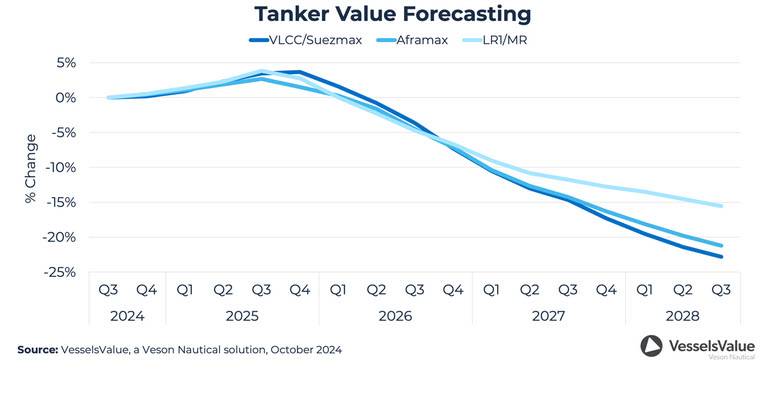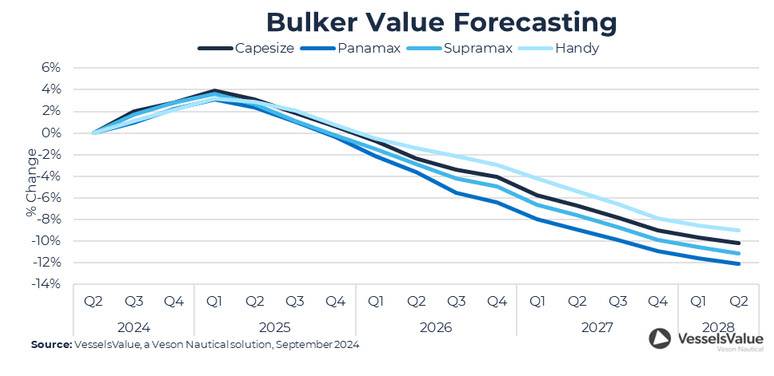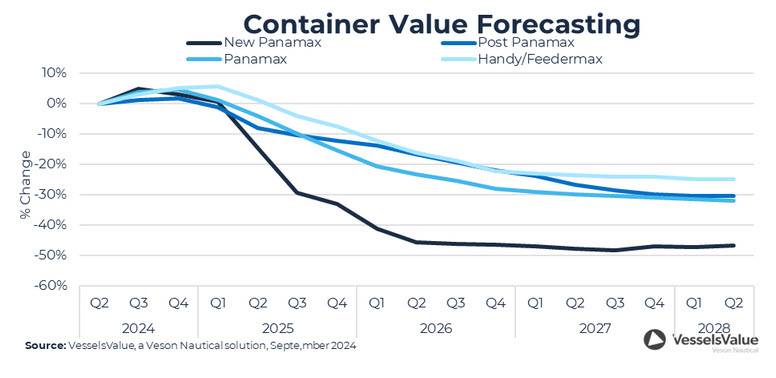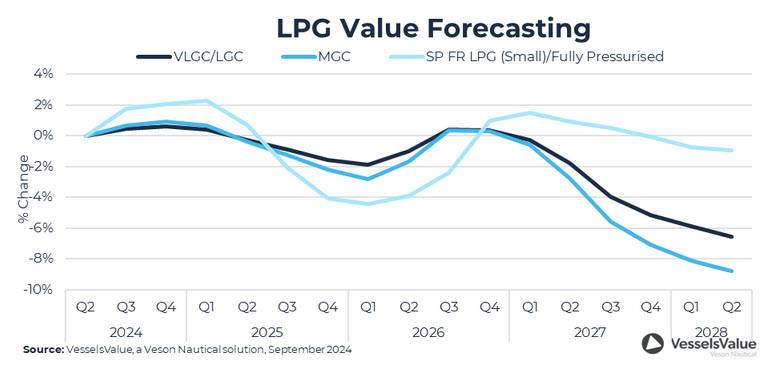Global Orderbook Likely to Shrink
VesselsValue has released its Q4 2024 Market Outlook indicating a forecast period up to 2027 which suggests a mixed outlook across different vessel types.
The company anticipates that orders for bulkers and tankers will gain momentum, while demand for containers and LNG/LPG vessels will decline. Despite the expected rise in bulker and tanker orders, the overall orderbook will likely shrink due to a surge in deliveries for container and gas vessels.
Geopolitical tensions, such as the Houthi attacks in the Bab Al Mandeb Strait, are creating both risks and opportunities for shipping. The rerouting of vessels has supported various shipping segments, but the volatile nature of the conflict introduces significant uncertainty. A sudden halt in attacks could negatively impact shipping, while prolonged disruptions could offer upside potential.
Additionally, the global economic landscape remains uncertain due to geopolitical conflicts, sanctions and trade wars, which could affect demand.
The recovery of China's economy—crucial for global trade—is also unstable, and high interest rates in Western economies increase the risk of a potential recession, which could delay future growth.
Tankers

Volatility in rates and expectations will continue with movements in the oil price, Russian volume developments, preemptive measures in the Red Sea, OPEC+ decisions and members’ compliance as well as China’s ability to maintain economic growth, high crude imports and refinery runs.
VesselsValue expects Russian oil exports to continue to decline, with Europe sourcing from suppliers further afield such as the Middle East and Gulf (MEG), US and Latin America, and this will continue to support ton mile demand and therefore rates going forward.
Tanker ordering activity has continued at a relatively strong pace in 2024, already equaling order activity seen in 2023 at 36 mil DWT, levels not rivalled since 2017. The delivery schedule for 2024 is low, however, will gain pace in 2025 and onwards. The total tanker orderbook to fleet ratio, currently at 12%, has been increasing through 2023 and 2024.
Ton-mile demand expectations in 2024 and beyond remain strong in the current VesselsValue base case for both crude and product carriers, following negative developments in both 2020 and 2021. A key factor for stronger growth will be the recovery of oil demand in China, without being hindered by rising global oil prices.
“With no remedy in sight for the Houthi aggression in the Red Sea we expect that the positive impact of sailing longer distances to avoid risk areas in the Red Sea will continue. However, should the risk abate and be deemed acceptable to the industry with ships again returning to the Suez Canal, the market will likely face a downward correction.”
Bulkers

A low orderbook and limited supply growth continue to support a fundamentally strong bulker market going forward. Moderate demand growth is expected as interest rates ease in developing economies, investment in green energy accelerates and changing trade flows increase ton-miles.
Bulker values have increased significantly in the last year due to improving sentiment, and despite solid freight rate expectations, the potential upside looks limited due to already elevated levels. Secondhand values are also expected to receive downward pressure from declining newbuilding prices when the ordering activity of container and LNG vessels subside.
Rerouting has been a strong driver of demand growth this year, as longer journeys around the Panama Canal and the Suez Canal have increased sailing distances and ton-miles. The situation in Panama is improving and is expected to normalise in Q4. However, the conflict in the Red Sea remains highly uncertain with no end in sight, and so far this year, bulker transits through Suez have declined 37%.
Additionally, the ongoing war in Ukraine has extended shipping distances, which is expected to keep ton-mile values elevated, as the Western economies' separation from Russia appears to be a long-term shift.
Despite several stimulus measures initiated by the Chinese government, there has been no sign of improvement in the Chinese real estate sector. This will likely continue taking its toll on the Chinese steel production, as construction activity eases.
The ton-mile heavy China-Brazil iron ore trade is growing, and Vale is planning to expand capacity. In addition, the Simandou iron ore mine in Guinea is scheduled to open in the end of 2025, and it has a potential export capacity of 120 million tons of iron ore per year.
Containers

Demand growth for Containers is positive this year with the most growth in the transpacific eastbound trade at 22.4%. The current analysis by VesselsValue points to total TEU demand growth of 3.3% yearly average over the period 2024-2027, with a forecasted growth in 2024 of 14.9% due to the significant impact of rerouting around Africa.
With the current conflict in the Red Sea, freight rates have increased sharply and are expected to stay at high levels throughout 2024. Longer sailing distances, congestion at ports and an earlier than expected peak season have increased demand for goods and supply has not managed to keep up with this pace.
Vessel supply growth in our forecast period will at some point outpace demand despite the Red Sea conflict, and this will affect freight rates for all sizes. Net fleet growth was recorded at 5.4% in 2023 which we expect will rise at an average pace of 7.8% between 2024-2027.
With the elevated freight rates, container ship ordering activity has been at a record high with 2 million TEU’s being ordered in the last quarter. With almost 8 million TEU’s entering the market over the next couple of years, we expect a supply surplus despite the ongoing rerouting.
With the recent strong market, VesselsValue expects muted scrapping activity in 2024 with only 76,000 TEUs sold for scrap so far this year. With the EU ETS being live and a general tightening of CO2 emissions regulations, it is anticipated that operating elderly non-eco vessels will become increasingly costly. This is especially pertinent given the forecasted decline in rates from 2025 and onwards. Many of these older vessels may find their way to the scrapyard.
Gas

In the US, VesselsValue expects LPG production to grow at a more moderate pace than previous years and forecast a growth of 4.4% in 2024, despite a strong 1Q24. Exports out of the US have been strong so far this year, but with less production growth for the remainder of the year and an expected active hurricane season. The VesselsValue forecast anticipates export growth of 7% compared to 13.4% in 2023.
Market players are still ordering very large ammonia carriers (VLACs), and the orderbook has reached 51 vessels with several vessels expected to be delivered in 2026 and 2027. However, VesselsValue does not expect these vessels to trade ammonia in their first years, but rather LPG until the ongoing blue and green ammonia projects are reaching sufficient volumes.
In 2025, normal activity is expected in the Panama Canal, and this will reduce the sailing distance compared to 2024. The stress on transits through the Panama Canal is likely to see large seasonal variations, with the recent drought last year in the Gatun Lake as something that could substantially impact the very large gas carrier (VLGC) transits in the following years. However, the Panama Canal Authority has approved an expansion in the canal reservoirs to limit the seasonal variations, but this is expected to take 18-24 months.
Asian demand for LPG is forecasted to see growth in 2024 for propane dehydrogenation (PDH) plants and domestic consumption. The PDH capacity in China is expected to increase with 7 million tons this year, but with muted operating rates, VesselsValue does not expect full utilisation.
So far this year, there has been a decline for all petrochemical gases as Asian demand is muted and US exports are seeing difficulties with the ongoing hurricane season. From 1Q25 a new ethylene terminal expansion is expected to go live and boost US ethylene export trade.












